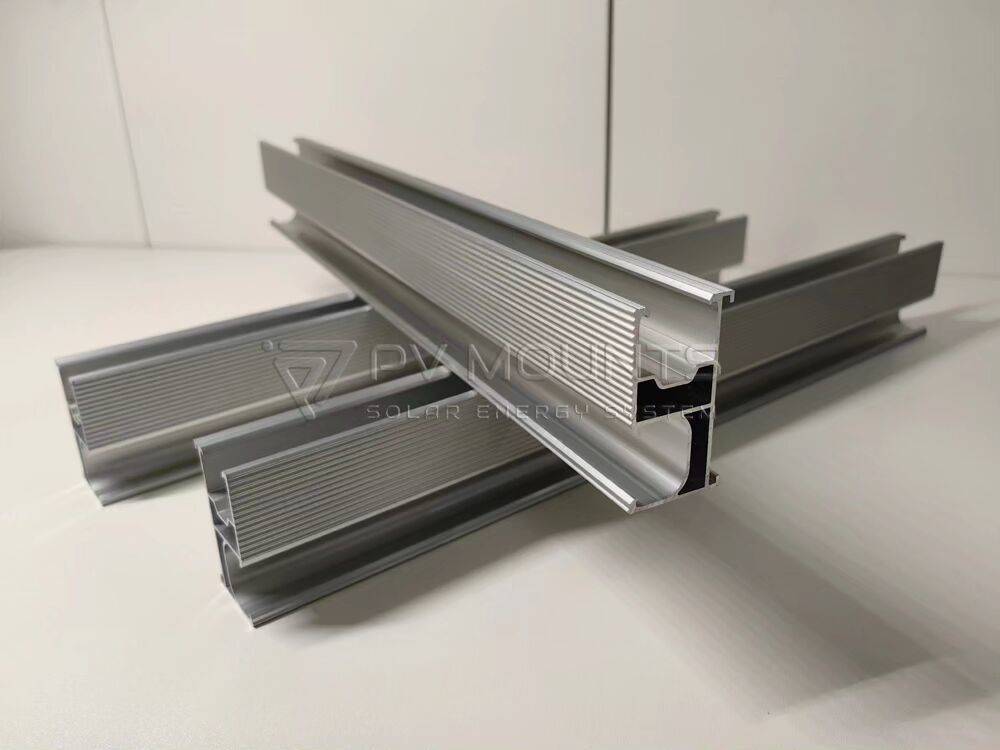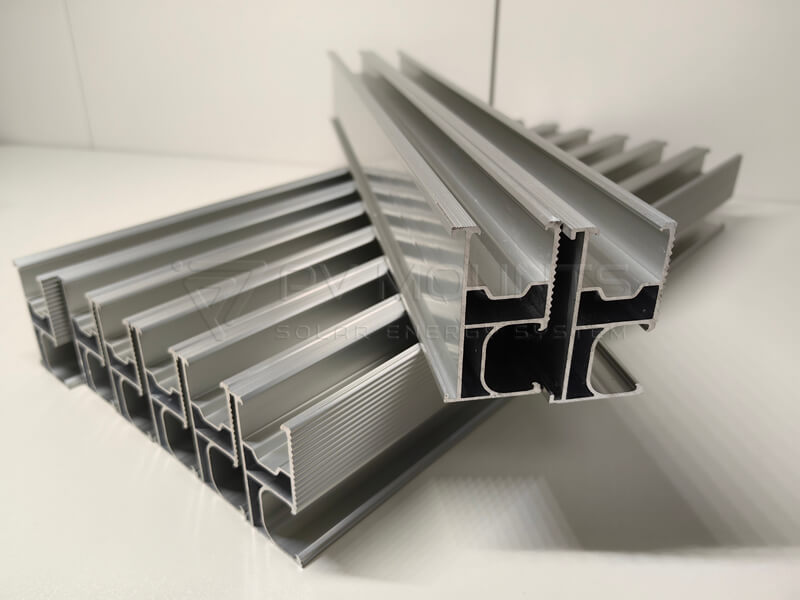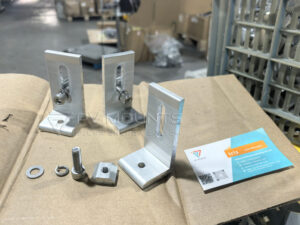A galvanikus korrózió nem csupán jelentős probléma, hanem potenciális veszély, amely alááshatja a napelemes rögzítő rendszerek szerkezeti integritását és hatékonyságát. Ez a fajta korrózió akkor következik be, amikor két különböző fém, például a rozsdamentes acél 304 és az alumíniumötvözet elektromos érintkezésbe kerül egy elektrolitikus környezetben, amelyet jellemzően a nedvesség segít elő. A napenergia egyre szélesebb körű elterjedése miatt a galvánkorrózió dinamikájának megértése és a megelőző intézkedések végrehajtása nem csak kritikus, hanem sürgős is a napelemes berendezések megbízhatóságának és hosszú élettartamának fenntartása érdekében.
Tartalomjegyzék
Az anyagok megértése: rozsdamentes acél 304 és alumínium ötvözet
Rozsdamentes acél 304
a kiváló korrózióállóságáról és tartósságáról széles körben ismert anyag, amely számos alkalmazásban kulcsszerepet játszik. Krómot tartalmaz, egy olyan összetevőt, amely a felületen króm-oxid védőréteget képez, hatékonyan védve a belső szerkezeteket a rozsdától és a romlástól. Ez az egyedülálló tulajdonság teszi népszerű választássá olyan környezetekben, ahol a nedvességnek és a korróziós elemeknek való kitettség gyakori jelenség

Az alumínium ötvözet tulajdonságai
Az alumíniumötvözetet, a napelemes rögzítő rendszerek másik kulcsszereplőjét könnyűsége és költséghatékonysága miatt tartják nagyra. Azonban érzékenyebb a korrózióra, különösen, ha nemesebb fémekkel, például rozsdamentes acéllal érintkezik. Az alumínium rozsdásodásra való hajlamát a galvánsorozat anódos jellege okozza, ami azt jelenti, hogy megfelelő óvintézkedések hiányában gyorsan tönkremehet.

A galvanikus korrózió mechanikája
A galvánkorrózió folyamatának megértése az első lépés a megelőzés felé. Ezt a jelenséget a két különböző fém közötti elektrokémiai potenciálkülönbség okozza. Amikor a 304 rozsdamentes acél és az alumíniumötvözet együttesen kerül felhasználásra, az alumínium, mivel anódosabb anyag, áldozati anódként működik, és gyorsabban korrodál, mint önállóan, míg a rozsdamentes acél katódként működik, és kevésbé korrodál. Ez a kölcsönhatás jelentősen befolyásolhatja a napelemes szerelőrendszerek teljesítményét és élettartamát, ezért a tervezés és karbantartás során figyelembe veendő lényeges szempont.
Hogyan történik a galvanikus korrózió
A folyamat akkor kezdődik, amikor a fémek érintkeznek egy elektrolit jelenlétével, amely lehet bármilyen vezető folyadék, általában víz. Az elektromos kapcsolat és az elektrolit jelenléte lehetővé teszi az elektronok áramlását az anódos anyagból (alumínium) a katódos anyagba (rozsdamentes acél), ami az anyag lebomlásához vezet az anódon.
A korrózió mértékét befolyásoló tényezők
Számos tényező befolyásolhatja a galvánkorrózió sebességét, beleértve az elektrolit elektromos vezetőképességét, az anódos és katódos területek relatív méretét és a fémek közötti távolságot. Az olyan környezeti tényezők, mint a hőmérséklet, a páratartalom és a sók jelenléte szintén fokozhatják a korróziós folyamatot. Például a magas hőmérséklet felgyorsíthatja a korróziós folyamatot, míg a magas páratartalom fokozhatja a nedvesség jelenlétét, megkönnyítve az elektrolit képződését és fenntartva a galvánhatást. Hasonlóképpen, a sók jelenléte, különösen a tengerparti területeken, növelheti az elektrolit elektromos vezetőképességét, ami gyorsabb korrózióhoz vezet.
A környezet hatása a korrózióra
A környezet döntő szerepet játszik a galvánkorrózió súlyosságában és sebességében. A különböző éghajlati viszonyok drasztikusan megváltoztathatják a napelemes szerelőrendszerek működési körülményeit, és ezáltal befolyásolhatják a korrózióra való hajlamukat.
A környezeti feltételek szerepe
A tengerparti területek például felgyorsíthatják a korróziót a magas sótartalom miatt, amely növeli az elektrolit vezetőképességét. Hasonlóképpen, a magas páratartalmú területek fokozzák a nedvesség jelenlétét, megkönnyítve az elektrolit képződését és fenntartva a galvánhatást.
Megelőző intézkedések a különböző éghajlati viszonyokhoz
E kihívások leküzdéséhez elengedhetetlen, hogy a napelemes szerelőrendszerek tervezése és karbantartása során figyelembe vegyük a környezeti tényezőket. A víz eltávolítására szolgáló vízelvezető rendszerek kiépítése, korrózióálló anyagok használata és védőbevonatok alkalmazása létfontosságú stratégiák. Emellett a rendszeres ellenőrzések segíthetnek a korrózió korai jeleinek felismerésében és mérséklésében, így meghosszabbítva a rendszer élettartamát és működőképességét.
Az érintett anyagok, a kölcsönhatásuk mechanikájának és a környezeti hatásoknak a megértésével Ön, mint érdekelt fél, hatékony stratégiát dolgozhat ki a galvánkorrózió megelőzésére. Az Ön szerepe ebben a folyamatban kulcsfontosságú, mivel biztosítja a napelemes rögzítő rendszerek tartósságát és hatékonyságát.
Megelőző stratégiák és legjobb gyakorlatok
A rozsdamentes acél 304 és az alumíniumötvözet közötti galvanikus korrózióval kapcsolatos potenciálisan súlyos kockázatok mérséklése érdekében a napelemes szerelőrendszerekben elengedhetetlen a tervezési módosítások, az anyagválasztás és a megelőző karbantartási stratégiák kombinációja. Ezek a legjobb gyakorlatok nemcsak a napelemes berendezések élettartamát hosszabbítják meg, hanem javítják azok általános teljesítményét is.
Anyagválasztási és tervezési megfontolások
A megfelelő anyagok kiválasztása kulcsfontosságú. Válassza a galvánsorozathoz közeli fémeket a potenciálkülönbségek minimalizálása és a korrózió mértékének csökkentése érdekében. A tervezési módosítások közé tartozhat a fémek elszigetelése a közvetlen érintkezéstől nem vezető gátak vagy alátétek használatával, valamint az illesztések kialakítása a vízvisszatartás minimalizálása érdekében.
Védőbevonatok és kezelések
A védőbevonatok, például festékek, porfestékek vagy anódos védelem alkalmazása hatékonyan megvédheti a sérülékenyebb fémet az elektrolittól. Az olyan kezelések, mint az alumínium eloxálása, fokozhatják a felület korrózióval szembeni ellenállását, így az tartósabbá válik a kedvezőtlen körülmények között.
Esettanulmányok: Valós alkalmazások
A sikeres és sikertelen berendezések vizsgálata segít rávilágítani az elmélet gyakorlati alkalmazására és a legjobb gyakorlatok betartásának fontosságára a galvanikus korrózió megelőzésében.
A sikeres telepítések elemzése
Azok az esettanulmányok, amelyekben 304 rozsdamentes acél és alumíniumötvözet felhasználásával nem merültek fel jelentős korróziós problémák, jellemzően aprólékos tervezéssel és megelőző intézkedésekkel járnak. Ezeknek a sikertörténeteknek meg kell nyugtatniuk Önt az általunk tárgyalt stratégiák hatékonyságát illetően, mint például az epoxi bevonatok és gumitömítések használata a közvetlen fémérintkezés és a nedvesség bejutásának megakadályozására.
A kudarcos esetekből levont tanulságok
Ezzel szemben a hibás esetek gyakran elhanyagolnak egy vagy több megelőző intézkedést. Egy figyelemre méltó eset egy óceán melletti napelemes létesítményt érintett. A védőbevonatok hiánya és a rossz anyagválasztás súlyos korrózióhoz vezetett, ami jelentősen csökkentette a rendszer élettartamát és növelte a karbantartási költségeket.
Innovációk a korrózióvédelemben
Az anyagtudomány és a mérnöki tudomány fejlődése folyamatosan innovatív megoldásokat vezet be a galvánkorrózió elleni küzdelemre, különösen a napelemes rögzítő rendszerek esetében.
Az anyagtudomány legújabb eredményei
Új ötvözeteket és kompozit anyagokat fejlesztenek ki, amelyek ellenállóbbak a korrózióval szemben. Ezek az anyagok jobb teljesítményt nyújtanak anélkül, hogy kiterjedt védelmi intézkedésekre lenne szükség, ezáltal csökkentve a napelemes rendszerek tervezésének költségeit és összetettségét.
Új technológiák a korrózióvédelemben
Egyre elterjedtebbek az olyan technológiai újítások, mint az intelligens bevonatok, amelyek képesek önmagukat gyógyítani vagy a korrózió korai szakaszában jelezni, valamint a katódvédelmi rendszerek, amelyek elektromos árammal csökkentik az anódos anyag elektrokémiai potenciálját.
Napelemes szerelőrendszerek karbantartása
A rendszeres karbantartás elengedhetetlen a napelemes szerelőrendszerek élettartamának meghosszabbításához és a további hatékony működésük biztosításához. A karbantartási protokollokat a rendszer egyedi igényeihez kell igazítani, figyelembe véve a felhasznált anyagokat és a helyi környezeti feltételeket.
Rutinellenőrzési és karbantartási protokollok
A rendszeres ellenőrzésekkel a galvánkorrózió korai jelei észlelhetők. Ezek közé tartozik a vizuális ellenőrzés, a fémvastagság mérése és a védőbevonatok sértetlensége. A karbantartás magában foglalhatja a tisztítást, a védőrétegek újbóli felhordását és a romlás jeleit mutató alkatrészek cseréjét.
Hosszú távú fenntarthatósági gyakorlatok
A fenntartható gyakorlatok magukban foglalják az anyagok kiválasztását nemcsak a költség és a funkcionalitás, hanem a környezeti hatás és a hosszú élettartam alapján is. A fenntarthatóságra összpontosító megközelítés alkalmazása tartósabb és környezetbarátabb napelemes szerelőrendszereket eredményezhet.
E stratégiák integrálásával az érdekelt felek hatékonyan kezelhetik és mérsékelhetik a galvánkorrózió kockázatát, biztosítva a napelemes szerelőrendszerek robusztusságát és fenntarthatóságát. Ez a proaktív megközelítés hosszú távon nemcsak költségeket takarít meg, hanem hozzájárul a megújuló energiainfrastruktúrák megbízhatóságához és hatékonyságához is.
Galvanikus korrózió a rozsdamentes acél 304 és az alumíniumötvözet között
Ez a szakasz a rozsdamentes acél 304 és az alumíniumötvözet közötti különleges kölcsönhatásokat vizsgálja a napelemes rögzítő rendszerekben, részletes elemzést nyújtva a korróziós mechanizmusokról és a hatékony kezelés stratégiáiról.
A kölcsönhatások részletes elemzése
Ha a 304 rozsdamentes acél és az alumíniumötvözet együttesen, elektrolit jelenlétében kerül felhasználásra, galvánelem alakul ki. A rozsdamentes acél, mivel kevésbé reaktív, katódként viselkedik és védett; eközben az alumínium, mivel reaktívabb, anódként viselkedik és korrodálódik. Ez a kölcsönhatás fokozódik magas nedvesség- vagy sótartalmú környezetben.
Következtetés: Összegzés: Jövőbeli irányok és összefoglalás
A rozsdamentes acél 304 és az alumíniumötvözet közötti galvánkorrózió kezelése a napelemes rögzítő rendszerekben a fenntartható infrastruktúrafejlesztés kritikus szempontja. A technológiák fejlődésével és az anyagok kölcsönhatásának jobb megértésével a korrózió megelőzésére és mérséklésére irányuló stratégiák javulni fognak. A vázolt gyakorlatok elfogadásával, valamint a folyamatos oktatás és konzultáció révén történő tájékozódással az érdekelt felek biztosíthatják, hogy napelemes berendezéseik hatékonyak és tartósak maradjanak, hozzájárulva a megbízható és hatékony megújuló energiaforrásokkal kapcsolatos általánosabb cél eléréséhez.













